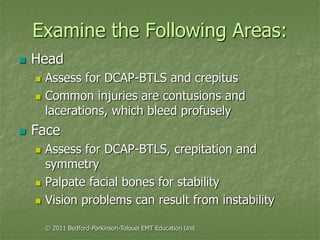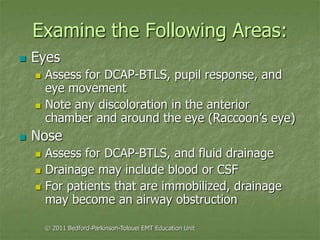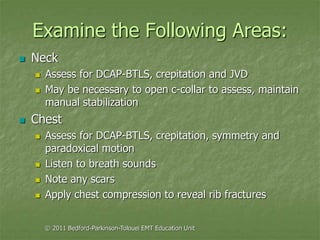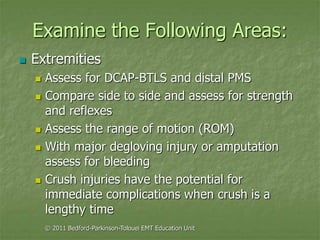Principles of assessment for ems chapter 11
- 1. Principles of Patient Assessment in EMS
- 2. Chapter 11 ŌĆō Detailed Physical Examination ┬® 2011 Bedford-Parkinson-Tolouei EMT Education Unit
- 3. Objectives ’ü« Describe the patients on whom the EMS provider should perform a detailed physical examination (DPE). ’ü« Explain when the EMS provider would perform a DPE. ’ü« Describe how and why the approach to the DPE is modified for children. ’ü« List the three general types of closed soft tissue injuries that the EMS provider may discover during an examination. ┬® 2011 Bedford-Parkinson-Tolouei EMT Education Unit
- 4. Objectives (continued) ’ü« Describe the various types of open soft tissue injuries that the EMS provider may discover during an examination. ’ü« List the body areas and specific assessment points for each. ’ü« Explain how the acronym DCAP-BTLS may be useful during the DPE. ┬® 2011 Bedford-Parkinson-Tolouei EMT Education Unit
- 5. Objectives (continued) ’ü« Provide an example of when the DPE would not be performed by the EMS provider. ┬® 2011 Bedford-Parkinson-Tolouei EMT Education Unit
- 6. Introduction ’ü« The detailed physical exam (DPE) is a complete head-to-toe exam for the non- life or limb-threatening conditions. ’ü« The DPE is performed on trauma patients with a significant MOI. ’ü« The DPE is usually completed during transport unless there is a delay. ┬® 2011 Bedford-Parkinson-Tolouei EMT Education Unit
- 7. Detailed Physical Exam ’ü« For most patients assess in a head-to-toe direction. ’ü« For young children the toe-to-head approach is used to decrease fear and anxiety. ’ü« Soft tissue injuries discovered are classified as ŌĆ£openedŌĆØ or ŌĆ£closed.ŌĆØ ┬® 2011 Bedford-Parkinson-Tolouei EMT Education Unit
- 8. Closed Soft Tissue Injuries ’ü« Contusion ’ü« Hematoma ’ü« Crush injuries ┬® 2011 Bedford-Parkinson-Tolouei EMT Education Unit
- 9. Open Soft Tissue Injuries ’ü« Abrasion ’ü« Avulsions ’ü« Incisions ’ü« Lacerations ’ü« Punctures/penetrations ’ü« Amputations ’ü« Impaled objects ’ü« Major artery lacerations ’ü« Crush injuries ┬® 2011 Bedford-Parkinson-Tolouei EMT Education Unit
- 10. Examine the Following Areas: ’ü« Head ’ü« Assess for DCAP-BTLS and crepitus ’ü« Common injuries are contusions and lacerations, which bleed profusely ’ü« Face ’ü« Assess for DCAP-BTLS, crepitation and symmetry ’ü« Palpate facial bones for stability ’ü« Vision problems can result from instability ┬® 2011 Bedford-Parkinson-Tolouei EMT Education Unit
- 11. Examine the Following Areas: ’ü« Eyes ’ü« Assess for DCAP-BTLS, pupil response, and eye movement ’ü« Note any discoloration in the anterior chamber and around the eye (RaccoonŌĆÖs eye) ’ü« Nose ’ü« Assess for DCAP-BTLS, and fluid drainage ’ü« Drainage may include blood or CSF ’ü« For patients that are immobilized, drainage may become an airway obstruction ┬® 2011 Bedford-Parkinson-Tolouei EMT Education Unit
- 12. Examine the Following Areas: ’ü« Ears ’ü« Assess for DCAP-BTLS and fluid drainage ’ü« Allow fluids to drain ’ü« Mouth ’ü« Assess for DCAP-BTLS, crepitation, loose or broken teeth, swelling or laceration of the tongue or throat, unusual odors, discoloration, and drainage ’ü« Assess need for suction or airway adjuncts ┬® 2011 Bedford-Parkinson-Tolouei EMT Education Unit
- 13. Examine the Following Areas: ’ü« Neck ’ü« Assess for DCAP-BTLS, crepitation and JVD ’ü« May be necessary to open c-collar to assess, maintain manual stabilization ’ü« Chest ’ü« Assess for DCAP-BTLS, crepitation, symmetry and paradoxical motion ’ü« Listen to breath sounds ’ü« Note any scars ’ü« Apply chest compression to reveal rib fractures ┬® 2011 Bedford-Parkinson-Tolouei EMT Education Unit
- 14. Examine the Following Areas: ’ü« Abdomen ’ü« Assess for DCAP-BTLS, guarding, rigidity, masses/bulging (pulsing or firm) or distension ’ü« Prior to palpation, listen for absence of bowel sounds (if feasible) ’ü« Ask the patient about distension or bloating ’ü« Do not touch any masses ’ü« Note any scars ’ü« Consider females of child bearing age to be pregnant ┬® 2011 Bedford-Parkinson-Tolouei EMT Education Unit
- 15. Examine the Following Areas: ’ü« Pelvis ’ü« Assess for DCAP-BTLS, crepitus, and stability ’ü« Apply pressure on pelvic ring and pubic synthesis ’ü« Reconsider the MOI for possible pelvic injury ’ü« Posterior ’ü« Assess back and buttocks for DCAP-BTLS and crepitation ’ü« When patient is on a long board prior to the exam, use fingers to reach under ┬® 2011 Bedford-Parkinson-Tolouei EMT Education Unit
- 16. Examine the Following Areas: ’ü« Extremities ’ü« Assess for DCAP-BTLS and distal PMS ’ü« Compare side to side and assess for strength and reflexes ’ü« Assess the range of motion (ROM) ’ü« With major degloving injury or amputation assess for bleeding ’ü« Crush injuries have the potential for immediate complications when crush is a lengthy time ┬® 2011 Bedford-Parkinson-Tolouei EMT Education Unit
- 17. Priority Determines Care ’ü« The DPE is conducted: ’ü« Only if time permits ’ü« Usually enroute to the hospital ’ü« When the patientŌĆÖs condition is critical the priority should be: ’ü« Necessary interventions ’ü« Serial initial assessments ’ü« Transport ┬® 2011 Bedford-Parkinson-Tolouei EMT Education Unit
- 18. Conclusion ’ü« The DPE is a thorough head-to-toe exam of the trauma patient who has significant MOI. ’ü« The approach differs for children (toe-to- head). ’ü« The DPE is completed enroute to the hospital if time and personnel permit. ’ü« Report all findings to the next care giver and carefully document your findings. ┬® 2011 Bedford-Parkinson-Tolouei EMT Education Unit


















